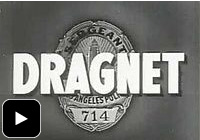Our newest briefing includes the first graphic we’re aware of that aggregates the disparate systems of confinement in this country into one big-picture chart.
March 12, 2014
Ever wonder exactly how many people are locked up in the U.S. and why? Many people, interested citizens and policy wonks alike, find that seemingly simple question to be frustratingly difficult to answer. Until now.
Today, the Prison Policy Initiative releases its newest briefing, Mass Incarceration: The Whole Pie, that includes the first graphic we’re aware of that aggregates the disparate systems of confinement in this country into one big-picture chart:

As we discuss in our briefing, this broader context pulls back the curtain and reveals answers to questions such as:
- How many people are behind bars for drug offenses?
- Which system holds more people: state prisons, federal prisons, or local jails?
- How many kids are locked up for offenses that most people don’t even think of as crimes?
- Where do we even have to look to find everyone who’s behind bars for immigration-related issues?
At the end of the day, locking up the more than 2.4 million people represented on this pie chart gives the United States the dubious distinction of being the number one incarcerator in the world. Policymakers and the public both have a pressing responsibility to take a good hard look at each slice of this pie and weigh any potential benefit of keeping those people behind bars against the significant social and fiscal cost.
The Prison Policy Initiative is thrilled to be chosen as one of three CharitySub organizations addressing this month’s “prison epidemic” theme.
by Peter Wagner,
March 3, 2014
 The Prison Policy Initiative is thrilled to be chosen as one of three CharitySub organizations addressing this month’s “prison epidemic” theme.
The Prison Policy Initiative is thrilled to be chosen as one of three CharitySub organizations addressing this month’s “prison epidemic” theme.
CharitySub is an innovative new approach to online giving. CharitySub members pledge $5 a month, and each month CharitySub picks a new cause and identifies three non-profits making a difference on that cause. Each month, CharitySub members get to pick which of the three organizations receives their $5.
You can join today to support this month’s organizations and learn about other organizations doing great work in the future.
"[I]f left unregulated, the video communication market could follow the trajectory of the infamously broken prison telephone industry."
by Leah Sakala,
February 28, 2014
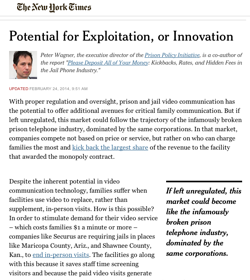
Prison Policy Initiative Executive Director Peter Wagner weighed in this week on a New York Times Room For Debate discussion about video visitation in prisons and jails. As Peter explained,
With proper regulation and oversight, prison and jail video communication has the potential to offer additional avenues for critical family communication. But if left unregulated, this market could follow the trajectory of the infamously broken prison telephone industry, dominated by the same corporations.
For more of our work on the prison and jail video visitation industry, check out our FCC filing on the subject and the New York Times editorial that it inspired.
As an undergraduate sophomore studying comparative politics at Smith College, this nonprofit granted me skills that exceeded my expectations.
by Catherine Cain,
February 27, 2014
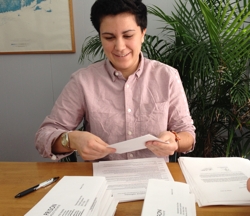
Over the month of January, I worked full-time with the Prison Policy Initiative for three consecutive weeks. As an undergraduate sophomore studying comparative politics at Smith College, this nonprofit granted me skills that exceeded my expectations and any of my previous experiences with research.
Before working with PPI I had been building a potential passion for prison justice. In my prior work with the legal department at El Sol Neighborhood Resource Center, I became more aware of racial profiling and its effect on immigrant communities. That same summer the Trayvon Martin case sparked protests against Stand Your Ground laws. I delved into documentaries, such as The House I Live In, and flipped through The New Jim Crow as I began to think about these issues within the context of mass incarceration. Although I had become engaged in these issues, I had not yet developed an agenda to act upon this interest.
As soon as I heard about the Prison Policy Initiative, I got in contact with a friend interning with them. I browsed their website and was impressed by their presence on social media pages. I did not have a strong idea what prison gerrymandering was before coming across the Prison Policy Initiative, but I quickly found videos of Executive Director Peter Wagner explaining this and other concepts central to this nonprofit’s mission.
My first project was creating a state legislator outreach database. Our goal was to find state legislators that have passed “progressive” bills relating to PPI’s efforts in order to have them as a contact regarding these issues in the future. Through this project I became more fluent in the bill-making process. While I understood that the War on Drugs and related legislation significantly contribute to the United States’ alarmingly high incarceration rate, I also became familiar with bills addressing mental health of incarcerated people, lowering the size of drug free zones, repealing mandatory minimum sentences, decriminalizing marijuana and other “soft” drugs, and requiring racial impact statements.
By individualizing each letter, the initiative could quickly connect with the legislator. The last thing we wanted was to spam them with generic pages of information because it would simply waste both the legislator’s and our time. I was surprised at how much thought went into the legislator’s response on behalf of Peter and Leah, who guided me through this project. At the end of my time with PPI, we sealed 200 customized letters and sent them to their respective offices.
My second project with the Prison Policy Initiative was crosschecking their internal Locator database against census data to ensure that correctional institution populations match up. Locator files are organized by state, giving the incarcerated population for census blocks and matching these blocks to specific facilities. This is essential to PPI’s work for identifying and addressing circumstances of gerrymandering.
So how do you find prisons? State and Federal facilities are much easier to find online than local facilities (i.e. county jails). Florida’s Department of Corrections actually has great and up-to-date information on their state and local facilities. These were extremely useful when matching up incarcerated populations. Apart from the Locator tool, the Initiative has extensive resources that allow you to look at facilities for each state through Google Earth and Google Maps among other excellent features.
Most of the research I did at PPI used tools to navigate raw data with rather than swimming through secondary sources, as I had been used to within my academic endeavors. Although this intimidated me at first, I received tremendous support from the staff at PPI.
Throughout my time here, I continuously felt like an equal — intellectually and on a personal level. For example, since I am focusing on comparative politics in my studies, I was asked to give feedback on an upcoming project on international incarceration rates. First of all, I thought this was a great idea to publish on the website. But I was really pleased that my opinion was so valued by a strong non-profit like PPI. This sentiment did not fade throughout my time here.
At some point, every staff member at PPI pulled me aside to show me what they’re working on. I read letters from incarcerated people who came across the Prison Policy Initiative, was asked for feedback on an upcoming presentation, and was introduced to Peter Wagner’s favorite books about American criminal justice system. Even on my last day of work, I was encouraged to chime in on conversations about PPI’s next moves.
Peter and Leah wrote a new Huffington Post piece about the start of the FCC's inter-state prison phone rate regulation on Tuesday.
by Leah Sakala,
February 13, 2014
To celebrate the FCC’s inter-state prison phone call charge regulation going into effect on Tuesday (just in time for Valentine’s Day!), Peter and I wrote a new piece for the Huffington Post.
The FCC’s regulation is a huge milestone in the decade-long fight for fair phone charges for the families of incarcerated people, and there’s lots more to be done. As we wrote:
…the fight for fair phone charges is one that the families of the 12 million people cycling through jails each year can’t afford to lose. Interstate rate regulation was a huge step forward that must now be defended in court, and the FCC and state and local governments need to keep going in order to protect all families, regardless of whether their loved ones are incarcerated in the same state or elsewhere. Our movement is strong, and we’re committed to ensuring that all parents, partners, and kids can afford to affirm their love for one another over the phone next Valentine’s Day.
We also spoke with American Public Media’s Marketplace yesterday for a story on the FCC’s prison phone regulation.
For more on what this regulation means for families and friends, check out the Campaign for Prison Phone Justice’s great new FAQ.
The two largest prison phone companies, mislead correctional facilities and federal regulators by acting like communications technology is stuck in the 1950s.
by Peter Wagner,
February 11, 2014
Today is a historic day: the Federal Communications Commission’s new rules take effect that cap the cost for inter-state calls home from prison and jail at a still-expensive but much-improved rate of 21 to 25 cents per minute. The FCC is exploring expanding its regulation to apply to the bulk of calls which are in-state in nature, and other important proposed restrictions have been stayed by the federal courts while prison telephone giants like Securus and its corporate allies sue the federal government for daring to end the industry’s monopolist price gouging.
As we’ve demonstrated in several lengthy reports and filings to the FCC, the high cost of phone calls from prison is driven by a kickback system in which private companies get monopoly contracts in exchange for sharing the majority of the revenue with the same correctional agency that awarded the contract.
So while Securus sues to protect its windfall profits off the backs of families, I’d like to point out just how far out of step rates like $1/minute are in a world of modern electronic communications.
Contrary to what the phone companies would have you believe, important security technology isn’t what’s driving the cost of these calls. In fact, a call home from New York State prisons costs 4.8 cents a minute because that state refuses kickbacks and negotiates the contract on the basis of the lowest cost to the consumer. But the very same company charges close to $1/minute in other states. As we’ve said again and again, it’s all about the profit.
But aside from the contemporary arbitrariness of the charges in this industry, taking a look at the historical perspective sheds some additional light on why the FCC has to drag this industry kicking and screaming into the 21st century. You see, Securus and Global Tel*Link, the two largest prison phone companies, mislead correctional facilities and federal regulators by acting like it’s still the 1950s, when transmitting a long-distance call was a deeply expensive and laborious manual process.
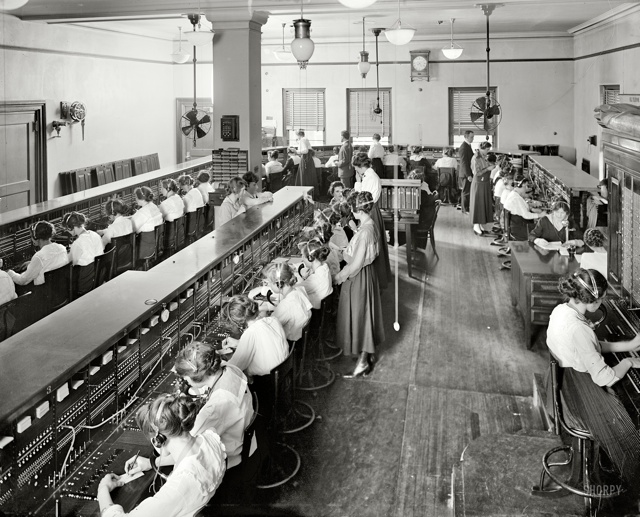 Why do most prison and jail phone contracts assume that a long distance call requires an army of telephone operators like the ones in this photo from 1919?
Why do most prison and jail phone contracts assume that a long distance call requires an army of telephone operators like the ones in this photo from 1919?
Check out this radio dramatization from Dragnet of a long distance call in 1954. That tedious 1 minute 22 second process wasn’t much better than the very first inter-continental telephone call in 1919, which took 5 operators 23 minutes to connect Alexander Graham Bell with his former assistant Thomas Watson. Fortunately technology has vastly improved since then, and these days prison and jail telephone companies sell digital communications products for which distance is simply not a factor. These companies know, however, that it’s in their best interest to leave sheriffs in the dark about these 21st century technological advances. With the possible exception of some of the smaller companies that are pushing one-size-fits-all “postalized” rates, the phone corporations don’t appear to be lifting a finger to educate the sheriffs about the real cost of the telephone services being contracted.
The industry’s lack of transparency about the actual cost of providing telephone service is quite similar to its practice of hiding fees, which we discussed in detail in our second report. Essentially, the phone industry rakes in additional profit by tacking on extra fees and hiding them from the commission system. As a result, the sheriffs are led to believe that they have negotiated a good deal with the phone company, but the hidden fees preserve far more profit for the industry than it lets on. That’s why our report included an appendix with questions that the sheriffs should ask about fees when negotiating these contracts.
So, at the end of the day, how far out of whack is a $1 a minute phone call? We did some research to figure out the last time a regular U.S. long distance phone call cost $1 per minute. Adjusting for inflation, a call hasn’t cost that much since 1950:
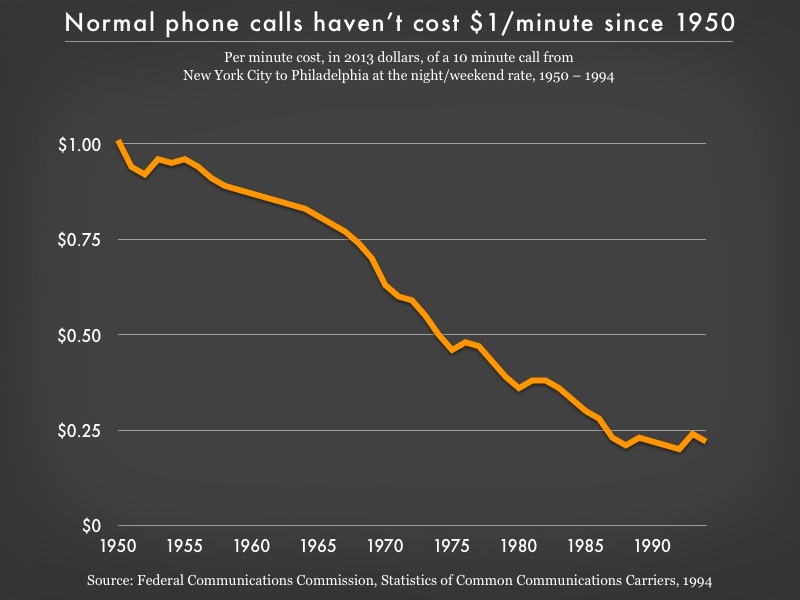
Peter Wagner will discuss the hidden costs of mass incarceration on 2/10.
by Leah Sakala,
February 6, 2014

Western New England University has released a press release detailing Peter’s upcoming Clason Speaker Series talk, “Overdosing on prisons: Tackling the side effects of the United States’ globally unprecedented use of the prison” this Monday, February 10th:
Wagner will discuss the hidden costs of mass incarceration for our democracy, our economy, and public safety. A 2003 graduate of the Western New England University School of Law, Wagner co-founded the Prison Policy Initiative in 2001, building an independent study project into a national movement against prison gerrymandering. His efforts have led to new legislation in four states including Maryland, where the law he helped write was affirmed by the United States Supreme Court. Wagner’s work has been featured in hundreds of newspapers nationwide, winning editorial endorsements for criminal justice reform from such publications as The New York Times> and the Boston Globe.
This lecture is free and open to the public. Hope to see you there!
Mark your calendars and RSVP today!
by Leah Sakala,
February 6, 2014
Hey Western Massachusetts-area friends, mark your calendars and RSVP today for an opportunity next Tuesday evening to meet and network with some awesome local advocates and organizations working towards more fair and effective justice policy, including:
- American Friends Service Committee
- ARISE
- Baystate Health
- Civil Liberties and Public Policy Program
- Communities for Restorative Justice
- EPOCA
- Hampshire Students Against Mass Incarceration (SAMI)
- Justice for Ayyub
- Justice for Pioneer Valley
- Just Schools Project
- Mount Holyoke College Students Against Mass Incarceration (SAMI)
- Out Now
- The Performance Project
- Prison Birth Project
- Prison Legal News
- Prison Policy Initiative
- Real Cost of Prisons Project
- Robert F. Kennedy Children’s Action Corps
- Rosenberg Fund for Children
- Springfield Institute
- Tranzmission Prison Project
- UMass Students Against Mass Incarceration (SAMI)
- Western Mass. Jobs with Justice
- Western Mass Recovering Learning Community
The Prison Policy Initiative is co-organizing this event with the Prison Birth Project, and here are the details:
When: Tuesday, February 11th 2014 from 6-7:30 PM
Where: Peace Development Fund Office, 44 N. Prospect St. Amherst, MA
What: Pizza, conversation, and one-minute introductions from each organization
Hope to see you there!
Sarah advocates tirelessly to improve our criminal justice system, including working on projects to end prison gerrymandering and remove barriers to participation in our democratic process.
by Leah Sakala,
February 5, 2014

The Minnesota Women’s Press has published a wonderful profile of Sarah Walker, Prison Policy Initiative board member and founder of the Minnesota Second Chance Coalition.
Sarah tirelessly advocates to improve our criminal justice system, and her work includes projects to end prison gerrymandering, remove barriers to participation in our democratic process, promote gender-responsive justice policy, and overcome harmful racial disparities.
Congratulations, Sarah!
We asked The New York Times consumer protection columnist the Haggler to investigate the broken prison phone industry. He did!
by Leah Sakala,
February 3, 2014
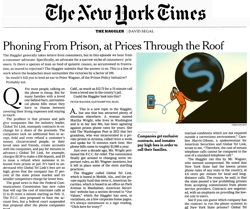
We asked The New York Times consumer protection columnist David Segel (AKA “the Haggler”) to look into the outrageous charges that families are forced to pay to speak on the phone with incarcerated loved ones.
And he did! Peter’s letter and the Haggler’s investigation were printed in yesterday’s paper.





